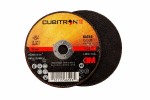Resistance over time: how long do abrasive discs last?
How long do abrasive discs last? When buying abrasive discs for use on angle grinders, it is natural to wish to know the lasting power of circular abrasive discs is, if nothing else to be able to estimate, roughly, how many discs will be needed to complete a task, or how many abrasive discs will be needed for a month of normal activity in a workshop or on worksite.
Giving a precise answer to this question, however, is not as simple as one might think: the factors to take into account and that can decisively influence the result are many.
Obviously, what causes a difference in lasting power are the different types of abrasive discs, not to mention their quality. Then, the usage, correct or otherwise, must also be taken into account, as it can be very different from case to case: abrasive disc can be used to eliminate the burrs resulting from welding, for sanding surfaces, for polishing, for finishing, and so on.
The service time of abrasive discs
But what is the data to look for when asking how long abrasive discs last? Well, it all depends on the use, as previously mentioned: this is why it is more correct define it as the “service life” of an abrasive disc, to indicate the effective time during which you can use that tool before it becomes inefficient, requiring replacement.
Thus, the service duration could be expressed in minutes or hours, or even in finished parts for each individual disc.
What makes results vary, as anticipated, is not only the type of processing, but also the type and quality of the abrasive disc itself, or the abrasive grain present on its surface. Obviously, what determines differences in service life are also the binding agent used, which can vary in terms of type and hardness.
Types of abrasive discs
So, to get an idea of the resistance of an abrasive disc over time, it is best to consider its type, and then the quality of the abrasive material used. Among the most common abrasive discs are so-called fibre grinding discs, circular abrasive discs made of vulcanized fibre coated with abrasive grain and synthetic resin (as a binder).
There are, it must be noted, different versions of fibre abrasive discs from which to choose according to the type of processing to be carried out and the material to be sanded. Zirconium, ceramic grain, aluminium oxide, and so on.
The fibre discs have a low price, good elasticity, a high level of adaptability, can achieve a very fine and homogeneous finish.
On the other hand, and this has to be highlighted, considering the theme of this article, fibre grinding discs are characterized by a rather low service life.
Things change in the case of lamellar abrasive discs, which boast a longer service life. It is easy to distinguish lamellar abrasive discs from fibre ones at first glance: the former have visible lamellae applied along the disc’s circumference and, because of this, they are sometimes called radial discs.
These discs, less elastic and less adaptable than those already outlined, are mostly used for deburring; given their structure, they have a higher purchase cost, justified, among other things, by their greater durability.
It should also be noted that lamellar discs do not present any major problems in terms of overheating and clogging of the abrasive material, making processing more effective and faster.
There are also other types of abrasive discs, from those made with paper to those in film material, all the way to abrasive discs made with non-woven fabric, for specific uses. The main types, in any case, are those described in detail above: the fibre and lamellar discs.
How long do abrasive discs last?
As noted, fibre discs last much less than radial lamellar discs. Their cost, however, is very different, which makes fibre discs an excellent solution in some cases.
Quality fibre discs should be considered, such as 3M’s Cubitron fibre discs, which feature extremely hard triangular-shaped ceramic grain – twice as hard as standard abrasives as well as very sharp– increasing the overall service life of the abrasive disc.
With high-quality abrasive discs, even if fibre ones, it is possible to process more pieces per disc, requiring fewer replacements. Specifically, 3M’s ceramic grain’s sharp points are designed to work as individual cutting tools, and to self-sharpen continuously through predefined breakages of the tips.







